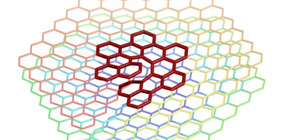
Twisting graphene into spirals
Japanese researchers synthesize helical nanographene
It's probably the smallest spring you've ever seen.
Researchers from Kyoto University and Osaka University report for the first time in the Journal of the American Chemical Society the successful synthesis of hexa-peri-hexabenzo[7]helicene, or 'helical nanographene'.
These graphene constructs previously existed only in theory, so successful synthesis offers promising applications from nanoscale induction coils, to molecular springs for use in nanomechanics.
Graphene -- a hexagonal lattice of single layer carbon atoms exhibiting outstanding charge and heat transport properties -- has garnered extensive research and development interest.
Helically twisted graphenes have a spiral shape. Successful synthesis of this type of graphene could have major applications, but its model compounds have never been reported. And while past research has gotten close, resulting compounds have never exhibited expected properties.
"We processed some basic chemical compounds through step-by-step reactions, such as McMurry coupling, followed by stepwise photocyclodehydrogenation and aromatization," explains first author Yusuke Nakakuki. "We then found that we had synthesized the foundational backbone of helical graphene."
The team confirmed the helicoid nature of the structure through X-ray crystallography, also finding both clockwise and counter-clockwise nanographenes. Further tests showed that the electronic structure and photoabsorption properties of this compound are much different from previous ones.
"This helical nanographene is the first of its kind," concludes lead author Kenji Matsuda. "We will try to expand their surface area and make the helices longer. I expect to find many new physical properties as well."

Fig. 1. Schenmatic concept of nanographenes.
(Osaka University and Kyoto University)

Fig. 2. Chemical structure of the nanographene synthesized in the present work.
(Osaka University and Kyoto University)

Fig. 3. Molecular structure of the nanographene synthesized in the present work (movie).
(credit: Osaka University and Kyoto University)
To learn more about this research, please view the full research report entitled " Hexa-peri-hexabenzo[7]helicene: Homogeneously π-Extended Helicene as a Primary Substructure of Helically-Twisted Chiral Graphenes " at this page of Journal of The American Chemical Society .
Related links
